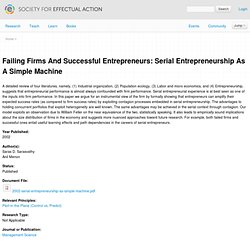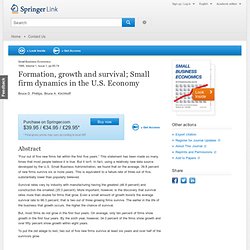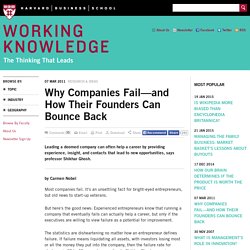

Internet Startups: Web 2.0 Success And Failure Rates. VCs: What's Your Failure Rate? Six Interesting Stats About Startup Success. This weekend, I reviewed a recent paper titled “Skill vs.

Luck in Entrepreneurship and Venture Capital: Evidence From Serial Entrepreneurs” by Paul Gompers, Anna Kovner, Josh Lerner and David Scharfstein from Harvard. Regular readers of OnStartups will not be surprised that a paper with this kind of title caught my eye. It’s hard to find good, reasonably well supported writings on the topic of startups and this particular paper stood out for me.
I read through the paper and captured a few data points that I found really interesting and thought worthy of sharing with you. My hope is that it sparks some interesting dialog and conversation. I have not been able to find a copy of this paper on the web yet (otherwise I would have linked to it). Update: One of the readers of OnStartups.com was kind enough to share a link to the full paper.
You can access it here for free: SEA - Society for Effectual Action. A detailed review of four literatures, namely, (1) Industrial organization, (2) Population ecology, (3) Labor and micro economics, and (4) Entrepreneurship, suggests that entrepreneurial performance is almost always confounded with firm performance.

Serial entrepreneurial experience is at best seen as one of the inputs into firm performance. In this paper we argue for an instrumental view of the firm by formally showing that entrepreneurs can amplify their expected success rates (as compared to firm success rates) by exploiting contagion processes embedded in serial entrepreneurship. The advantages to holding concurrent portfolios that exploit heterogeneity are well known. The same advantages may be achieved in the serial context through contagion. Our model exploits an observation due to William Feller on the near equivalence of the two, statistically speaking. Small Business Economics, Volume 1, Number 1. “Four out of five new firms fail within the first five years.”

This statement has been made so many times that most people believe it is true. But it isn't. In fact, using a relatively new data source developed by the U.S. Small Business Administration, we found that on the average, 39.8 percent of new firms survive six or more years. Formation, Growth and Survival; Small Firm Dynamics in the U.S. Economy by Bruce Phillips, Bruce Kirchhoff. Bruce D Phillips National Federation of Independent Business Bruce A.

Kirchhoff affiliation not provided to SSRN1989 University of Illinois at Urbana-Champaign's Academy for Entrepreneurial Leadership Historical Research Reference in Entrepreneurship. And How Their Founders Can Bounce Back. Most companies fail.

It's an unsettling fact for bright-eyed entrepreneurs, but old news to start-up veterans. But here's the good news: Experienced entrepreneurs know that running a company that eventually fails can actually help a career, but only if the executives are willing to view failure as a potential for improvement. The statistics are disheartening no matter how an entrepreneur defines failure. If failure means liquidating all assets, with investors losing most or all the money they put into the company, then the failure rate for start-ups is 30 to 40 percent, according to Shikhar Ghosh, a senior lecturer at Harvard Business School who has held top executive positions at some eight technology-based start-ups. If failure refers to failing to see the projected return on investment, then the failure rate is 70 to 80 percent. "Very few companies achieve their initial projections," says Ghosh. Why start-ups fail.
What is the truth behind "9 out of 10 startups fail" Infographic: Most startups fail because of premature scaling. While most entrepreneurs dream of growing their startups into a beast like Facebook, most never reach global domination, get Hollywood treatment, and become worth billions of dollars like the social network.

Statistically speaking though, successful startups are a rare breed. One out of every ten startups do fail, eventually. Bjoern Herrmann wants to crack the code of innovation. To discover what makes up the DNA of successful companies, he needs to understand why they fail. Herrmann co-founded The Startup Genome Report to survey 3,200 startups, a research initiative that used machine learning to identify the startup's type and stage.
It turns out, many companies that fail suffer from premature scaling. "[Premature scaling] helped us to explain about 74% of failures," he said to me. So what exactly is premature scaling? Startups are temporary organizations that are designed to evolve into large companies, Herrmann said. The No. 1 reason startups fail: Premature scaling. Don't get too big, too fast.

(Via Willie Wonka and the Chocolate Factory) Startups can blow up for any number of reasons: bad hires, overspending, lack of capital. In fact, a new study from the Startup Genome Report finds that 90 percent of startups fail primarily because of “self-destruction rather than competition.” And what’s the biggest reason why? The study of more than 3,200 high-growth technology startups pinpoints the issue on what it calls “premature scaling.” Startup Business Failure Rate By Industry.